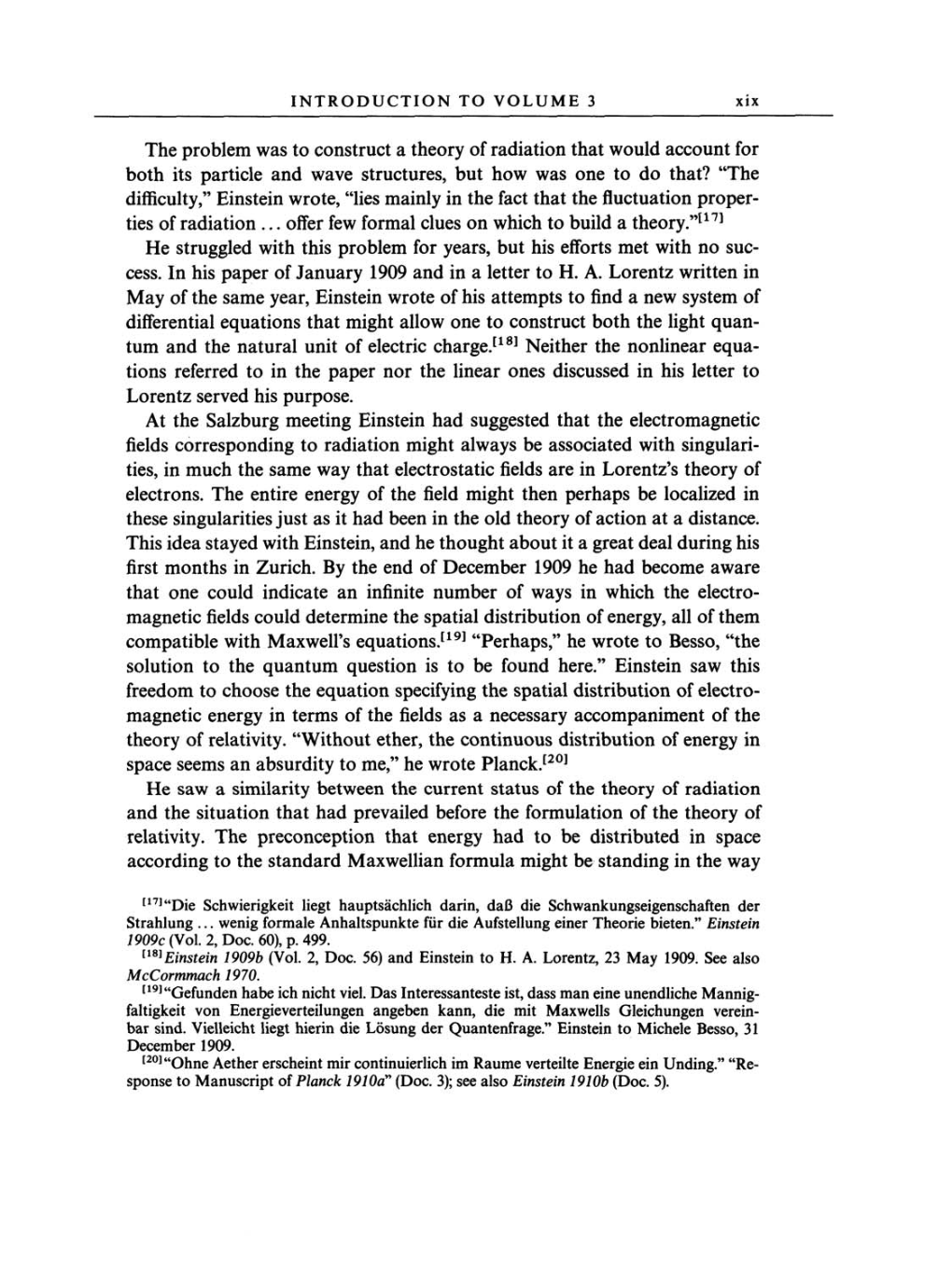INTRODUCTION TO VOLUME
3
xix
The
problem was
to construct
a
theory
of radiation
that
would
account
for
both
its
particle
and
wave
structures,
but
how
was
one
to
do that? "The
difficulty,"
Einstein
wrote, "lies
mainly
in the fact
that
the fluctuation
proper-
ties
of radiation
...
offer few
formal
clues
on
which
to
build
a theory."[17]
He
struggled
with this
problem
for
years,
but
his efforts met
with
no
suc-
cess.
In his
paper
of
January
1909
and in
a
letter
to H. A.
Lorentz written in
May
of
the
same
year,
Einstein
wrote
of
his
attempts
to find
a
new system
of
differential
equations
that
might
allow
one
to construct
both the
light quan-
tum
and the
natural
unit of electric
charge.[18]
Neither the nonlinear
equa-
tions referred
to
in the
paper
nor
the linear
ones
discussed in his letter
to
Lorentz served his
purpose.
At the
Salzburg meeting
Einstein had
suggested
that
the
electromagnetic
fields
corresponding
to
radiation
might always
be
associated with
singulari-
ties,
in much the
same
way
that
electrostatic
fields
are
in Lorentz's
theory
of
electrons. The entire
energy
of
the field
might
then
perhaps
be
localized in
these
singularities just as
it had been in the old
theory
of action
at
a
distance.
This idea
stayed
with
Einstein,
and he
thought
about
it
a
great
deal
during
his
first months in Zurich.
By
the end of December
1909
he had become
aware
that
one
could indicate
an
infinite number of
ways
in which the electro-
magnetic
fields
could determine the
spatial
distribution of
energy,
all
of them
compatible
with Maxwell's
equations.[19]
"Perhaps,"
he wrote to
Besso,
"the
solution
to
the
quantum question
is to
be found here." Einstein
saw
this
freedom
to
choose the
equation
specifying
the
spatial
distribution of electro-
magnetic energy
in
terms
of the
fields
as
a
necessary accompaniment
of the
theory
of
relativity.
"Without
ether,
the continuous distribution of
energy
in
space seems
an
absurdity
to
me,"
he
wrote Planck.[20]
He
saw a
similarity
between the
current status
of the
theory
of radiation
and the situation
that
had
prevailed
before the formulation of the
theory
of
relativity.
The
preconception
that
energy
had
to
be distributed in
space
according to
the
standard
Maxwellian formula
might
be
standing
in
the
way
[17]"Die
Schwierigkeit liegt hauptsächlich
darin,
daß die
Schwankungseigenschaften
der
Strahlung
...
wenig
formale
Anhaltspunkte
für die
Aufstellung
einer Theorie bieten." Einstein
1909c
(Vol. 2,
Doc.
60), p.
499.
[18]Einstein 1909b
(Vol. 2,
Doc.
56)
and Einstein to
H. A. Lorentz, 23
May
1909. See
also
McCormmach
1970.
[19]"Gefunden
habe ich nicht
viel.
Das Interessanteste
ist,
dass
man
eine unendliche
Mannig-
faltigkeit
von
Energieverteilungen angeben kann,
die mit Maxwells
Gleichungen
verein-
bar sind. Vielleicht
liegt
hierin die
Lösung
der
Quantenfrage."
Einstein
to
Michele
Besso,
31
December
1909.
[20]"Ohne
Aether erscheint mir continuierlich
im
Raume verteilte
Energie
ein
Unding."
"Re-
sponse
to
Manuscript
of Planck
1910a"
(Doc.
3);
see
also
Einstein 1910b (Doc.
5).
